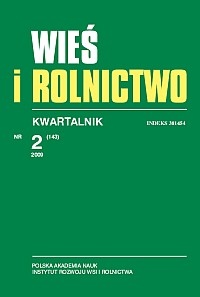Wpływ polityki spójności na integrację gospodarczą i społeczną w Unii Europejskiej w latach 1988-2008
The Impact of Cohesion Policy on Economic and Social Integration in EU in 1988–2008
Author(s): Dorota Czykier-Wierzba, Paweł WierzbaSubject(s): Economy
Published by: Instytut Rozwoju Wsi i Rolnictwa Polskiej Akademii Nauk
Keywords: European Union; cohesion policy; structural funds; Cohesion Fund; member-states; effects of cohesion policy; Unia Europejska; polityka spójności; fundusze strukturalne; Fundusz Spójności; kraje członkowskie; efekty polityki spójności
Summary/Abstract: The cohesion policy was adopted in 1988 with the purpose of reducing disproportions in the level of development of various regions of the Community's countries, and eliminating the backwardness of the underprivileged areas, rural areas included. In accordance with decisions taken at the time the cohesion policy was to be financed from structural funds, i. e. from the Orientation Section of FEOGA (the European Agricultural Guidance and Guarantee Fund), the European Regional Development Fund, the European Social Fund and — from 1993 — the Financial Instrument for Fisheries Guidance and, also, the Cohesion Fund. Since 1988 the cohesion policy has been modified several times (in 1994-1999, 2000—2006 and 2007—2013). In the 1988—2006 period the main beneficiaries of assistance available from the EU funds were the poorest member-states of the European Union — Spain, Greece, Portugal and Ireland. These countries allocated the obtained means to the development of infrastructure, human resources and production environment. The use of means obtained from the EU funds in 1988—2006 helped reduce the difference in the le-vel of development of the named countries and the remaining countries of EU-15. Polityka spójności ustanowiona została w 1988 roku. Celem jej było zmniejszenie dysproporcji w poziomie rozwoju regionów w krajach Wspólnoty oraz zmniejszenie zacofania najsilniej upośledzonych obszarów, w tym również obszarów wiejskich. Przyjęto wówczas, że polityka ta będzie finansowana z funduszy strukturalnych, tj. Sekcji Orientacji funduszu FEOGA, Europejskiego Funduszu Rozwoju Regionalnego, Europejskiego Funduszu Społecznego i od 1993 roku – Finansowego Instrumentu Wspierania Rybołówstwa, a także Funduszu Spójności. Od 1988 roku polityka ta była kilkakrotnie modyfikowana (w latach 1994–1999, 2000–2006 i 2007–2013). W latach 1988–2006 głównymi beneficjantami pomocy z funduszy unijnych były najbiedniejsze kraje członkowskie UE – Hiszpania, Grecja, Portugalia i Irlandia. Kraje te przeznaczyły uzyskane środki na rozwój infrastruktury, czynnika ludzkiego i otoczenia produkcyjnego. Wykorzystanie w latach 1988–2006 środków z funduszy unijnych przyczyniło się do ograniczenia dysproporcji w poziomie rozwoju pomiędzy wymienionymi krajami a pozostałymi krajami UE-15.
Journal: Wieś i Rolnictwo
- Issue Year: 143/2009
- Issue No: 2
- Page Range: 93-112
- Page Count: 20
- Language: Polish

